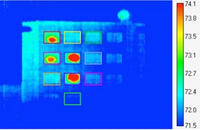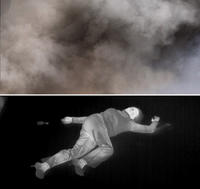-
SurveillanceIndustry fights Pentagon efforts to restrict exporting of infrared products
The global market for infrared technology products will be worth about $2.6 billion dollars by 2017; the technology can be used for commercial products such as automotive, surveillance, and security industries – and is heavily used by the military; three major U.S. infrared equipment makers fight the Pentagon’s efforts to restrict exports of devices based on the technology for fear these devices may enhance the military capabilities of adversaries of the United States
-
-
Law–enforcement technologyThermal imaging proves useful for police
With the help of sophisticated new thermal imaging systems police officers around the United States have been able to apprehend criminals and locate car crash victims in perfect darkness without a hitch
-
-
Digital robberyThermal imaging allows ATM theft from a distance

ATMs’ PINs can be stolen using thermal imaging cameras; when ATM customers press down keys to enter their personal code number, they leave behind residual heat from their fingertips; thermal imaging cameras can catch these numbers
-
-
SurveillanceVumii unveils new thermal imaging cameras

Vumii, a firm that specializes in developing surveillance cameras, recently announced the addition of four new thermal imaging camera lines, expanding on its existing line of LED and laser-illuminated cameras
-
-
Night visionSaudi Arabia seeks $330 million worth of night vision gear
Saudi Arabia is looking to buy $330 million worth of night vision and thermal vision equipment from the United States; the U.S. government agency facilitating the deal says the proposed sale would bolster Saudi Arabia’s capability to meet current and future threats from potential adversaries during operations conducted at night and during low-visibility conditions
-
-
Insider threats in Afghanistan increase need for explosive detectors
In Afghanistan suicide bombers are increasingly disguising themselves as friendly forces to successfully infiltrate secure allied bases and wreak havoc; April has been a deadly month for allied troops in Afghanistan with at least four attacks taking place where suicide bombers disguised themselves as police officers or members of the army; to protect against this threat, Thermal Matrix specializes in person-borne improvised explosive device (PBIED) detection devices; the firm has been working with the U.S military for the past several years to develop the Thermal Matrix ACT system which is capable of detecting suicide bombers from long distances; the system uses infrared imagery to analyze the heat signature of approaching individuals to determine if they are carrying any explosives
-
-
The food we eatTechnology tracks produce from growth to delivery

The new federal food safety bill has sparked a technology race among companies to provide simple electronic tracking systems for individual items of produce; the new law mandates that each part of the supply chain keep electronic records of where they received items from and where they shipped it to; this comes as a result of a large salmonella outbreak in 2008 that reached more than forty states and infected more than 1,300 people; poor records led to misidentification and slow recalls in that outbreak; every year 3,000 people die from food-borne illnesses while one in six people suffer from food poisoning
-
-
In the trenchesStealthy robo-snake to gather info in inaccessible areas
Israeli researchers develop a robotic snake that could be useful in urban and subterranean warfare, enabling the inspection and surveillance of sewage systems, narrow tunnels, or culverts, inaccessible by other systems; the robo-snake can maneuver through difficult terrain, “sneak” stealthily inside buildings, use its sensors to scan their interiors; the robot will be able to carry disposable sensors that could be separated and left behind to monitor activity inside buildings
-
-
New app turns cell phones into night vision devices
Researchers develop an application for cell phones which turn the phones into night-vision devices; standard night vision goggles use a photocathode to convert invisible infrared light photons into electrons; the new imaging device replaces the vacuum tube with several layers of organic semiconductor thin film materials
-
-
Liverpool police use thermal-imaging UAV to track and capture a car thief
Police in Liverpool used thermal-imaging device housed in a UAV to track down and capture a car thief; the technology allowed the operator to use live images of the suspect’s body heat to guide other officers to the man’s hiding place
-
-
Flir Systems forecast falls Short; CFO to retire
The company profit forecast falls short of expectations; profit for the fourth quarter was in line with Wall Street expectations; it earned $60.3 million, or 38 cents per share, in the last three months of the year. That matched the average forecast from analysts, according to a Thomson Reuters poll; profit in the year-ago quarter was $65 million
-
-
Thermal imaging enters the mainstream
FLIR guides thermal imaging into the mainstream; FLIR, a leading thermal imaging equipment manufacturer, helps the trend by lowering its price point; a residential thermal imaging camera can now be purchased for $3,500
-
- All
- Regional
- Water
- Biometrics
- Borders/Immig
- Business
- Cybersecurity
- Detection
- Disasters
- Government
- Infrastructure
- International
- Public health
- Public Safety
- Communication interoperabillity
- Emergency services
- Emergency medical services
- Fire
- First response
- IEDs
- Law Enforcement
- Law Enforcement Technology
- Military technology
- Nonlethal weapons
- Nuclear weapons
- Personal protection equipment
- Police
- Notification /alert systems
- Situational awareness
- Weapons systems
- Sci-Tech
- Sector Reports
- Surveillance
- Transportation
Advertising & Marketing: advertise@newswirepubs.com
Editorial: editor@newswirepubs.com
General: info@newswirepubs.com
2010-2011 © News Wire Publications, LLC News Wire Publications, LLC
220 Old Country Road | Suite 200 | Mineola | New York | 11501
Permissions and Policies
Editorial: editor@newswirepubs.com
General: info@newswirepubs.com
2010-2011 © News Wire Publications, LLC News Wire Publications, LLC
220 Old Country Road | Suite 200 | Mineola | New York | 11501
Permissions and Policies
